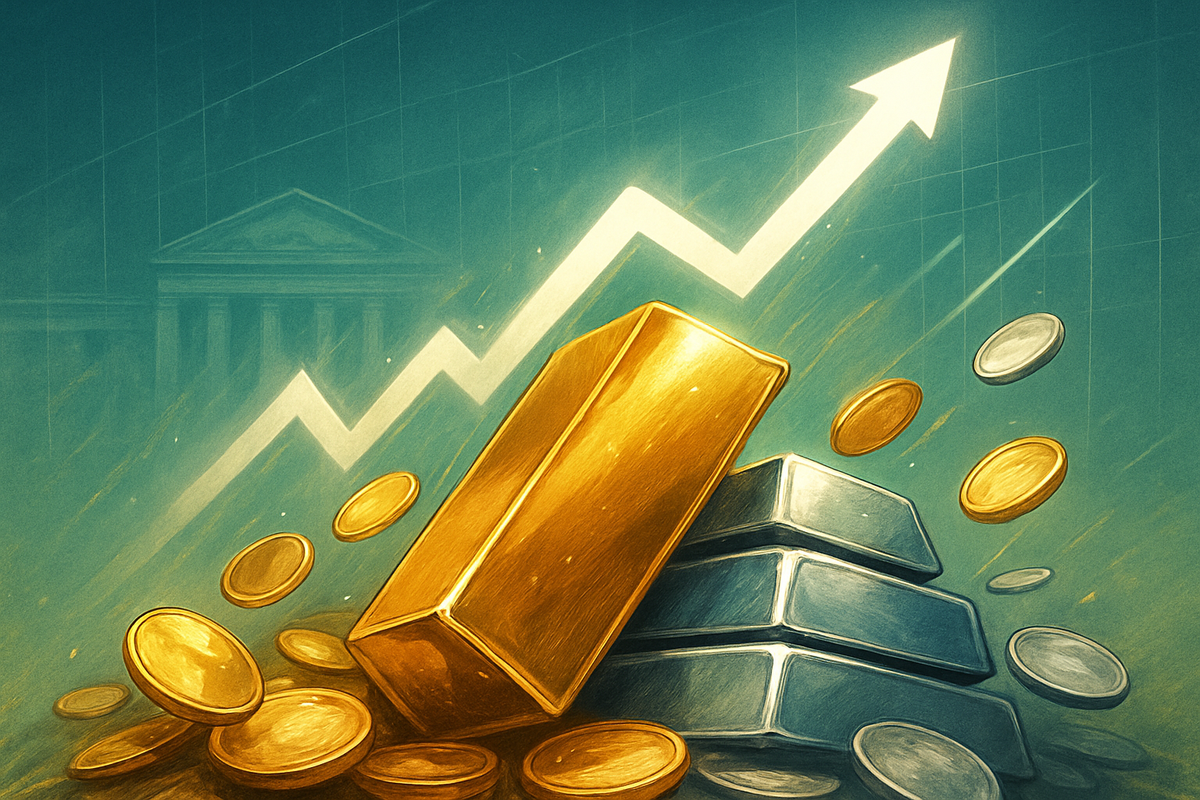
New York, NY – November 28, 2025 – The financial markets are currently witnessing a spectacular "Precious Metals Power Surge," with both gold and silver registering unprecedented gains as investors flock to safe-haven assets amidst escalating expectations of a U.S. Federal Reserve interest rate cut. This dramatic rally signals a profound shift in market sentiment, driven by the anticipation of looser monetary policy and its far-reaching implications for asset valuations globally. Gold is poised for its fourth consecutive monthly gain, while silver has emphatically shattered all-time record highs, underscoring a deep recalibration of investment portfolios.
The immediate implications of this surge are clear: a significant boost for precious metals, offering a hedge against economic uncertainties and a potentially weakening U.S. dollar. This phenomenon is rooted in the fundamental economic principle that lower interest rates reduce the opportunity cost of holding non-yielding assets like gold and silver, making them inherently more attractive compared to interest-bearing alternatives such as bonds.
The Dovish Domino Effect: How Fed Hopes Fuel the Rally
The primary catalyst for this extraordinary power surge is the market's robust conviction that the Federal Reserve is on the cusp of easing its monetary policy. As of November 28, 2025, market traders are assigning a high probability, ranging between 80% and 90%, to a 25-basis-point rate cut by the Federal Reserve in December 2025. This represents a sharp increase in dovish expectations, with further cuts also widely anticipated well into 2026. This sentiment has been reinforced by recent softer U.S. labor market readings, including falling job openings and weak wage growth, coupled with cooling U.S. economic data such as weaker-than-expected retail sales and consumer confidence. Additionally, dovish commentary from influential Fed officials, including New York Fed President John Williams, Federal Reserve Governor Christopher Waller, and San Francisco Fed President Mary Daly, has significantly contributed to these expectations.
The connection between dovish Fed expectations and the rally in precious metals is multifaceted. Firstly, lower interest rates directly diminish the opportunity cost of holding gold and silver, as the return on alternative investments like bonds becomes less appealing. This encourages fresh capital inflows into precious metal-backed exchange-traded funds (ETFs) and other investment vehicles. Secondly, expectations of easier monetary policy often lead to a weaker U.S. dollar. A depreciating dollar makes dollar-denominated assets like gold and silver more affordable and attractive for international buyers, thereby boosting demand. While the dollar has shown some resilience in November 2025, the overall trend of rate cut expectations supports a weaker dollar environment in the medium to long term.
This anticipation of a Fed rate cut profoundly influences investor sentiment by intensifying the role of precious metals as safe-haven assets and hedges. In periods of economic uncertainty, decelerating growth, and potential inflation, investors traditionally flock to gold and silver as reliable stores of value. The current macroeconomic landscape, characterized by lingering uncertainties and a shifting policy paradigm, reinforces this "flight to safety" sentiment. Furthermore, precious metals act as hedges against both persistent inflation and potential currency debasement, concerns that can arise from accommodative monetary policies. Consequently, investors are rapidly recalibrating their portfolios, increasing allocations to precious metals in anticipation of sustained bullish trends driven by lower borrowing costs and ongoing macroeconomic jitters.
The "Precious Metals Power Surge" has led to impressive performance metrics. Gold is trading robustly around $4,160 to $4,171 per ounce, having touched an all-time high of $4,381.58 in October. It is poised for its fourth consecutive monthly gain and has seen year-to-date gains hovering between 58% and 60%, positioning it for what analysts believe could be its strongest annual performance since 1979. Some analysts even predict gold could reach $4,900 to $5,000 per ounce by the end of 2026. Silver's rally has been even more explosive in percentage terms, soaring past $55 per ounce to reach new all-time record highs, with specific reports indicating highs of $55.66, $55.86, and even $56.52 per ounce in London trade on November 28, 2025. This surpasses its previous peak in October and represents an astounding year-to-date gain exceeding 81-85.87%, significantly outperforming gold and indicating powerful underlying demand, with a 17.16% surge in November alone.
Corporate Fortunes: Winners and Losers in the Metals Boom
A significant rally in gold and silver prices creates distinct winners and losers among public companies, influencing their revenue streams, profit margins, and strategic outlook.
Mining Companies: The Direct Beneficiaries Gold and silver mining companies are the most direct and substantial beneficiaries. Higher metal prices directly translate into increased revenue and potentially expanded profit margins, assuming production costs remain stable. Major gold miners poised to gain include Newmont (NEM), one of the world's largest gold producers; Barrick Gold (ABX), a global gold producer with significant operations; Agnico Eagle Mines (AEM), operating 11 mines across multiple countries; and Kinross Gold (KGC), another significant global producer. Mid-tier miners like Alamos Gold (AGI) and Equinox Gold (EQX) will also see enhanced profitability. In the silver sector, companies like Pan American Silver (PAAS), one of the world's largest primary silver producers; First Majestic Silver (AG), focused predominantly on silver production; Endeavour Silver (EDR); and Hecla Mining Co. (HL), a prominent U.S. silver producer, are experiencing significant tailwinds.
Royalty and Streaming Companies: Lower Risk, High Reward Precious metals royalty and streaming companies, which provide upfront capital to miners in exchange for future production or purchase rights at a fixed price, are also major winners. Their business model is often seen as lower-risk as they are shielded from operating costs and capital expenditure overruns. Leading players like Franco-Nevada (FNV), Wheaton Precious Metals (WPM), and Royal Gold (RGLD) stand to benefit from the increased value of their existing royalty and streaming agreements.
Exchange-Traded Funds (ETFs): Investor Access ETFs provide investors with exposure to precious metals without direct ownership. Physically backed ETFs like SPDR Gold Shares (GLD), iShares Gold Trust (IAU), iShares Silver Trust (SLV), and abrdn Physical Silver Shares (SIVR) see their net asset values directly correlate with the rising spot prices. Gold and silver miner ETFs such as VanEck Gold Miners ETF (GDX) and Global X Silver Miners ETF (SIL) also benefit from the improved performance of their underlying company holdings.
Potential Losers: Industries Facing Higher Input Costs Conversely, companies that use gold and silver as raw materials in their manufacturing processes or whose sales are negatively impacted by higher prices may face challenges. Jewelry retailers and manufacturers could experience squeezed profit margins if they cannot fully pass on increased material costs to consumers, potentially deterring demand for mass-market items. Luxury brands like Tiffany & Co. (TIF) or those under Richemont (CFR) might also face pressure, although high-end segments could see some demand for gold as a store of value. Electronics and industrial manufacturers that rely on gold and silver for their conductivity in components could see increased input costs. While the quantities used per unit are often small, major players like Apple and Microsoft could face minor increases in component costs, potentially impacting their supply chains and overall profitability if prices remain elevated.
A Broader Canvas: Significance Across Markets and Policy
The "Precious Metals Power Surge" is more than just a commodity rally; it signifies a profound shift in global financial market dynamics, reflecting deep-seated economic concerns and strategic policy adjustments.
Broader Commodity and Financial Market Trends: This rally is emblematic of a broader trend towards safe-haven assets and inflation hedges within the commodity complex. Lower interest rates typically weaken the U.S. dollar, making dollar-denominated commodities more attractive internationally. Beyond gold and silver, platinum and palladium have also joined the rally, indicating a widespread bullish sentiment across precious metals. In the wider financial markets, the anticipated rate cuts have spurred a rebound in risk assets, with U.S. indices like the S&P 500, Nasdaq, and Dow posting two-week highs, and global equities climbing. Bond yields have simultaneously declined, further reducing the attractiveness of interest-bearing investments relative to precious metals. Investment vehicles, particularly gold and silver-focused Exchange-Traded Funds (ETFs), are experiencing unprecedented capital inflows, with major ETFs adding hundreds of tonnes of physical metal. This underscores an accelerated institutional and retail investor demand, highlighting a strategic rotation into safer assets amidst stock market volatility and a compelling case for precious metals exposure in 2026.
Ripple Effects and Stakeholders: The surge creates a bifurcated landscape. Mining giants like Barrick Gold (ABX) and Newmont Corporation (NEM) are clear beneficiaries, alongside refiners, fabricators, and investment firms offering precious metal products. Commodity exchanges and brokerage firms also benefit from increased trading volume. Conversely, industries heavily reliant on the physical demand for gold and silver, such as the jewelry and certain industrial sectors, may face challenges as elevated prices could reduce consumer and manufacturing demand. Discussions around new tariffs on silver used in electronic components could also influence global supply chains, accessibility, and price points, leading to increased volatility and shifts in sourcing strategies for manufacturers.
Regulatory and Policy Implications: The dovish pivot by the Federal Reserve is itself a significant policy event. The anticipated interest rate cuts by the U.S. Federal Reserve throughout 2025 are the primary driver, following a 25-basis-point cut in December 2024. This dovish stance, signaled by various Fed officials, directly fuels investor sentiment. Beyond monetary policy, discussions are expected around restructuring tariff rates on imported gold, introducing new tariffs on silver in electronic components, and adjusting for a harmonized tariff framework. Environmental tariffs on mining operations with high carbon footprints are also under consideration. Furthermore, the reclassification of gold under Basel III banking regulations from a speculative holding to a Tier 1 reserve asset has fundamentally altered institutional participation, creating incentives for financial institutions to maintain significant precious metals exposure.
Historical Precedents: Historically, Fed policy has a clear influence on precious metals. Gold prices have consistently surged during Fed easing cycles, with past rallies ranging from 26% to 39% over 18-30 months. Periods of significant economic uncertainty, geopolitical instability, and high inflation, such as the 1970s oil shocks and stagflation, have always driven investors towards gold and silver. More recently, persistent global economic uncertainties and escalating geopolitical tensions continue to assert precious metals' role as indispensable safe havens. Central bank gold acquisitions have reached unprecedented levels since 2023, with official sector purchases totaling 1,037 tonnes in 2023 and continuing into 2025. BRICS+ nations, in particular, have shown a strategic shift toward gold reserves, adding over 800 tonnes between 2023 and mid-2025, indicating a deliberate move to reduce dependence on U.S. dollar-denominated assets. This behavior often continues even during periods of dollar strength, driven by long-term diversification strategies.
The Road Ahead: Navigating the Future of Precious Metals
The "Precious Metals Power Surge," largely propelled by dovish Federal Reserve expectations and a complex global economic landscape, is anticipated to maintain its upward trajectory into 2026, albeit with varying paces for gold and silver and specific strategic considerations for market participants.
Short-Term and Long-Term Possibilities: The outlook for gold from late 2025 into 2026 appears broadly bullish, suggesting a structural bull market is firmly in place. Major financial institutions like Deutsche Bank, Goldman Sachs, and Bank of America forecast average gold prices of US$4,450 to $4,538 per ounce in 2026, with potential highs near $4,900 to $5,055. This is driven by continued dovish Fed policy, persistent central bank accumulation, ongoing macroeconomic uncertainty, and declining real yields. While some analysts are "cautiously optimistic" for 2026, not expecting the same "big bang" returns as 2025, the long-term structural tailwinds remain strong. Silver, often considered the "poor man's gold," is positioned as the high-beta play, benefiting from its dual nature as both a monetary hedge and an industrial asset. Forecasts for silver vary, with UBS anticipating it could reach US$60 per ounce in 2026, and a Reuters poll expecting an average of $50 in 2026. This is supported by growing industrial demand from electric vehicles, solar energy, and 5G infrastructure, coupled with persistent supply deficits.
Strategic Pivots and Adaptations: The current environment necessitates strategic adjustments for investors. A growing number of analysts recommend a larger allocation to precious metals, with some endorsing a 60/20/20 portfolio strategy (60% stocks, 20% bonds, 20% gold). Dollar-cost averaging is advised to reduce timing risk given current elevated prices. Investors should also understand the volatility and relative performance of gold (stability, wealth preservation) versus silver (higher volatility, superior returns in accelerating bull markets). Emphasis is placed on owning physical gold and silver to mitigate counterparty risk, although ETFs offer liquidity.
Emerging Market Opportunities and Challenges: Emerging markets play a significant role. Opportunistic buyers in these regions can provide a floor under prices, and cyclical demand for gold is not yet peaked. Emerging market central banks retain greater policy flexibility, which, combined with potential further U.S. dollar weakness, could support demand. There may be a continued shift of capital out of heavily AI-concentrated U.S. markets towards more diversified opportunities in Europe, China, and emerging markets, benefiting precious metals. Industrial growth in emerging economies, particularly in green transition technologies, also contributes significantly to silver demand.
Potential Scenarios: The most likely scenario is a sustained bullish trend, with gold averaging $4,450-$4,560 per ounce in 2026 and silver reaching $50-$60 per ounce, driven by dovish Fed policy, persistent inflation, geopolitical tensions, and central bank buying. A moderate growth scenario suggests a moderation in the rally's pace, with gold increasing by about 5% and silver by 7.9% in 2026, as crisis hedging potentially experiences "burnout." Downside risks include a hawkish Fed shift, a severe equity market correction leading to liquidity drives, a slowdown in official central bank buying, or a significant resolution of geopolitical tensions.
Wrapping Up: A Golden Future Amidst Shifting Tides
The "Precious Metals Power Surge" of late 2025 marks a pivotal moment in financial markets, driven primarily by the escalating anticipation of a dovish U.S. Federal Reserve. The remarkable performance of gold and silver, with gold on track for its best year since 1979 and silver hitting all-time highs, underscores a fundamental shift in investor sentiment towards safe-haven assets.
The market moving forward is expected to remain highly sensitive to Federal Reserve communications and incoming economic data. The underlying economic rationale for this safe-haven demand—namely, the reduced opportunity cost of holding non-yielding assets in a lower interest rate environment, coupled with persistent inflation fears and geopolitical uncertainties—is likely to persist well into 2026. This structural support suggests that the current rally is not merely speculative but driven by deeper, long-term macroeconomic forces.
For investors, the key takeaways include the increasing importance of precious metals for portfolio diversification and wealth preservation. Companies involved in mining, royalty, and streaming for gold and silver are poised for continued strong performance, while industries reliant on these metals as raw materials will need to adapt to higher input costs. The wider significance extends to global commodity trends, financial market rotations, and potential regulatory shifts, particularly concerning tariffs and environmental considerations in mining.
In the coming months, investors should closely watch for further clarity on the Federal Reserve's rate cut trajectory, any significant shifts in global economic growth forecasts, and the evolution of geopolitical tensions. While the historic gains of 2025 may moderate, the long-term structural tailwinds appear to remain firmly in place, suggesting a continued, albeit potentially more measured, bullish outlook for precious metals. This period could indeed mark the "official start of the decade's great metals supercycle."
This content is intended for informational purposes only and is not financial advice








